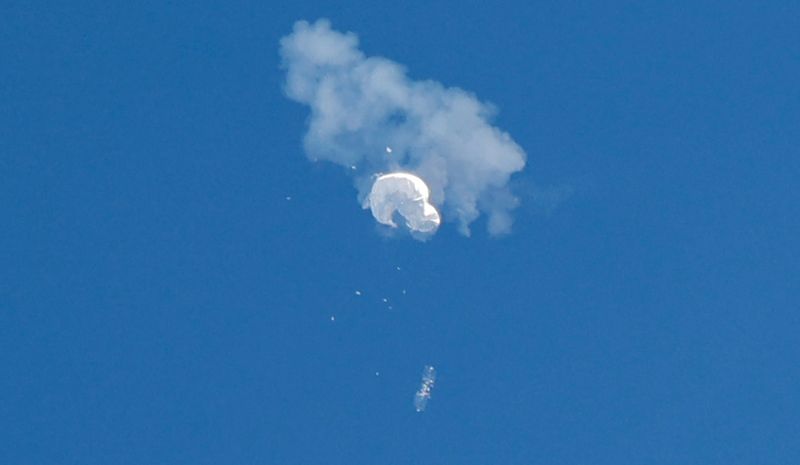By Eduardo Baptista and Greg Torode
BEIJING (Reuters) - As China and the United States tussle over what Washington says was a Chinese surveillance balloon over U.S. territory, dozens of Chinese documents point to surging interest in using balloon technology for military purposes.
China's foreign ministry has repeatedly described the balloon the drifted over the United States as an errant scientific craft, but Chinese military researchers have recently argued in publicly available papers that such aircraft should be further developed and deployed in specific missions.
One paper published last April by researchers in a People's Liberation Army (PLA) institute focused on "special aircraft" said that one of the useful military applications of balloons was to test enemy air defences.
"(The balloon can) induce and mobilise the enemy's air defence system, providing the conditions for the implementation of electronic reconnaissance, assessment of air defence systems' early warning detection and operational response capabilities," the researchers wrote.
That paper and several other articles by PLA-controlled publications also point to keen interest from the Chinese military establishment in studying how the United States and other countries used balloons militarily in the past, as well as a clear intent to close the gap in the field.
Balloons are also used for scientific purposes such as weather monitoring, including by the likes of the China Meteorological Administration.
The United States is working to recover debris after a U.S. fighter jet downed the balloon once it was over water off the South Carolina coast on Saturday. China condemned what it called an "over-reaction" and warned of possible retaliation.
While U.S. officials say that China has more discrete and sophisticated ways to gather intelligence on its rival, such as its network of spy satellites, the PLA paper also said the low cost of using balloons was one of the reasons China should further deploy them.
"In response to the growing threat posed by ground-based air defence systems to air attack forces, it is necessary to use cheap air balloons to create active and passive interference to effectively suppress enemy air defence early warning systems and cover air attack forces to carry out their missions," it argued.
The PLA paper appeared in Shipboard Electronic Countermeasure, a journal owned by a Chinese state-run shipping conglomerate that publishes articles on topics including signals-jamming and electronic warfare.
"In order to shorten the gap with foreign countries when it comes to air-drift balloons, and to prevent China from being attacked by such weapons, we should actively carry out ... research on related operational issues to enhance our military's offensive combat capability," it said.
Some regional security analysts say balloons could also gather data on the upper atmosphere useful for China's missile programmes, or be used for high resolution photography to supplement intelligence material available via satellites.
China's defence ministry did not immediately respond to a request for comment.
TECHNOLOGY PURCHASES
Chinese military units and state-run research institutes have bought high-altitude balloons and related technology in the past two years, a Reuters analysis of government tenders shows, though the documents are heavily redacted.
The Aerospace Information Research Institute, part of the official Chinese Academy of Sciences (CAS), is among state institutions to have shown interest in balloons, frequently publishing articles about high-altitude balloons on an official WeChat account.
While many of the articles focus on space exploration and balloon aerodynamics, others analyse how such aircraft have been deployed militarily in the past, with a particular focus on how other countries have defended themselves from threats posed by balloons and how they have been used offensively.
One, published last April, was titled, "New model of spy balloons defends Israeli skies".
Last September, the research institute won a 3.16 million yuan ($466,400) contract to develop a "stratospheric balloon platform" for another CAS department, according to a government tender.
A month later, it announced the successful trial of a balloon that can reach heights of 30 km and carry up to 1.2 tonnes. The trial was part of a high-priority CAS project for developing near-space technologies, according to an article published on the research institute's website.
Neither project specified military applications.

According to one of its articles, one of the institute's main missions is to help national defence projects achieve technological breakthroughs.
CAS did not respond to a request for comment.